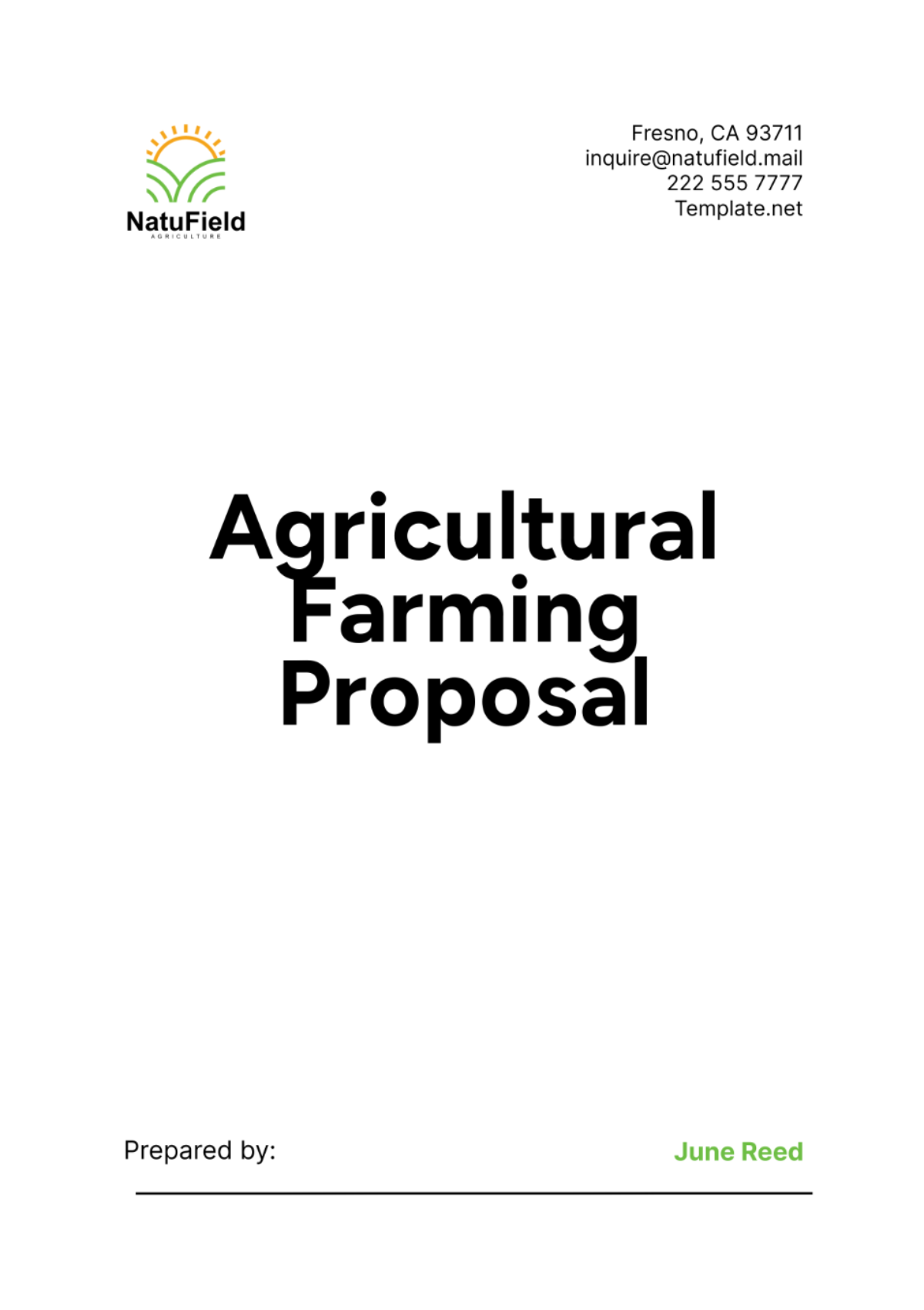Free Agricultural Farming Proposal

I. Introduction
A. Overview of the Proposal
We present this proposal to establish a state-of-the-art agricultural venture at [Your Company Name] in [Your Company Address]. This initiative aims to integrate advanced farming techniques with sustainable practices to serve as a model for agricultural innovation and community development. By leveraging modern technologies and environmentally conscious methods, we aim to create a thriving agricultural enterprise that enhances local food production and economic resilience.
B. Objectives of the Agricultural Project
Our objectives are multifaceted, focusing on increasing agricultural productivity, promoting sustainable land use practices, and fostering economic growth in the region. Through this project, we seek to not only meet local food demand but also to contribute positively to the environment by reducing our carbon footprint and enhancing biodiversity.
C. Importance and Benefits
The importance of this project lies in its potential to address key challenges such as food security and sustainable development. By implementing advanced farming methods and engaging with the community, we aim to create a resilient agricultural ecosystem that benefits local farmers, consumers, and the environment alike. The benefits extend beyond economic gains to include enhanced soil health, reduced water usage, and improved livelihoods for rural communities.
II. Project Description
A. Farm Location and Size
The agricultural enterprise is advantageously situated on [00] hectares of exceptionally fertile land in the region of [Location]. This area is widely recognized for its superior soil quality, which is ideal for growing a variety of crops. The climate in this region is particularly well-suited for agricultural activities, further enhancing the farm's productivity.
The farm's close location to major markets allows efficient distribution of crops and livestock, fostering diverse cultivation and effective management, maximizing its success in agricultural endeavors.
B. Type of Farming Activities
Crop Cultivation
Our crop cultivation plan includes the cultivation of high-value crops such as [Crops], chosen for their market demand and adaptability to local growing conditions. Crop rotation and integrated pest management will be integral to our farming practices.
Livestock Management
Integrated into our farming model will be sustainable livestock management practices focused on [Livestock], ensuring optimal animal welfare and high-quality product output. This includes pasture management, feed optimization, and humane handling practices.
C. Proposed Farming Techniques and Methods
Irrigation Systems
We will implement a combination of drip irrigation and rainwater harvesting systems to minimize water usage and ensure efficient crop hydration. This approach not only conserves water resources but also reduces operational costs and enhances crop yield stability.
Fertilization Practices
Emphasizing organic fertilizers and composting techniques, our fertilization strategy aims to enrich soil fertility while minimizing chemical runoff and environmental impact. Soil health assessments will guide nutrient application, ensuring optimal plant nutrition and sustainable land stewardship.
Pest and Disease Control
Integrated Pest Management (IPM) protocols will be employed, emphasizing biological control methods and selective pesticide application only when necessary. Regular scouting and monitoring will guide timely interventions, promoting crop health and minimizing ecological disruption.
III. Objectives
A. Specific Goals and Targets
Our specific goals include achieving a zero percent increase in crop yield within zero years, reducing water usage by zero percent, and improving soil organic matter content by zero percent. These targets are aligned with the sustainable development goals and are aimed at enhancing farm productivity while conserving natural resources.
B. Expected Outcomes and Deliverables
Yield Increase Targets
We are projecting an annual increase in production of [00] for crops and [00] for livestock products. This anticipated growth is attributed to the implementation of enhanced farming techniques and the optimization of resource management.
Environmental Sustainability Goals
Through the execution and integration of sustainable agricultural practices, we have set forth a comprehensive objective to significantly minimize the release of greenhouse gas emissions into the atmosphere. We are committed to efficient water management and conservation, ensuring its long-term availability and quality. We also focus on preserving and enhancing biodiversity in our farming, maintaining a balanced ecosystem. These efforts highlight our dedication to environmental stewardship and agricultural sustainability.
Economic and Social Benefits
The project is designed to stimulate local economic growth in a multifaceted manner. Firstly, it aims to generate employment opportunities, thereby creating new jobs for members of the community. In addition, the project will enhance market access for farmers, enabling them to reach a broader customer base and increase their sales and income. A key part of the project is launching community engagement programs aimed at agricultural education and skill development, equipping local farmers and residents to enhance practices and boost productivity. This initiative seeks to promote sustainable economic growth and improve quality of life in the community.
IV. Methodology
A. Detailed Plan of Action
Preparation Phase
Initial activities will include soil testing, land preparation, and infrastructure assessment to ensure optimal conditions for crop establishment and livestock housing. Environmental impact assessments and regulatory compliance checks will also be conducted during this phase.
Implementation Phase
The implementation phase will involve phased planting schedules, livestock acquisition, and installation of irrigation and energy-efficient infrastructure. Staff training on new technologies and farming methods will be prioritized to ensure smooth operations and maximize productivity.
Monitoring and Evaluation
Continuous monitoring of crop growth, soil health, and environmental parameters will guide adaptive management practices. Regular evaluations and data analysis will inform decision-making processes, allowing for timely adjustments and improvements to farming practices.
B. Technological Integration
Use of AI in Farm Management
AI-driven analytics will be employed to optimize planting schedules, predict crop diseases, and manage resources efficiently. Remote sensing technologies will provide real-time data on soil moisture levels and crop health, enabling proactive decision-making and resource allocation.
Digital Agriculture Tools
Mobile apps and farm management software will facilitate data collection, record-keeping, and communication among farm staff. These tools will streamline operations, enhance traceability, and improve overall farm management effectiveness.
V. Timeline
A. Phases of Implementation
Preparatory Stage
Months 1-3: Carry out comprehensive feasibility studies to evaluate the viability and potential impact of the project. Once the studies are completed, proceed to finalize the detailed design for the project, ensuring that every aspect is thoroughly planned and accounted for. Following the completion and approval of the project design, undertake the process of obtaining all the necessary permits and approvals from relevant authorities, ensuring that the project complies with all regulations and standards.
Farm Establishment
Months 4-6: Commence the process of preparing the land, developing the necessary infrastructure, and initiating the initial planting activities. Ensure that all these tasks are carried out in accordance with the specified seasonal calendars and the meticulously planned crop rotation schedules.
Growth and Maintenance
Months 7-12: Carry out the continuous management and execution of various agricultural tasks, which encompass optimizing the irrigation systems to ensure efficient water usage, developing and applying comprehensive strategies to manage and control pests effectively, and establishing and adhering to detailed protocols for the care and maintenance of livestock, ensuring their health and well-being.
Harvesting and Post-Harvest Handling
Months 13-15: Initiate the multiple phases of harvesting, implement comprehensive quality control procedures, and carry out all necessary post-harvest processing activities. This holistic approach is crucial to maintaining the product's integrity and ensuring that it is fully prepared and suitable for entry into the market.
VI. Budget
A. Cost Breakdown
Infrastructure Costs
The budget allocates funds for land acquisition, site preparation, and the construction of essential infrastructure such as irrigation systems and storage facilities. Estimated costs for infrastructure development total approximately $[00], ensuring a solid foundation for sustainable farming operations.
Equipment and Machinery
Investments in agricultural machinery, including tractors, harvesters, and processing equipment, are projected to account for $[00] of the budget. These tools will enhance operational efficiency and support timely cultivation and harvesting activities.
Labor and Training Expenses
Significant portions of the budget are earmarked for labor salaries, specialized training programs, and capacity-building initiatives, totaling $[00]. Training sessions on sustainable farming practices and operational safety will empower staff to execute their roles effectively.
B. Funding Requirements
Sources of Funding
Our funding will primarily draw from multiple key sources, encompassing government grants, private investments, and potential partnerships with organizations dedicated to agricultural development. We are actively pursuing these diverse sources of financial support to secure an amount of $[00] in funding. This targeted funding will be instrumental in covering the initial costs involved in setting up the project, as well as ensuring its sustainability over the long term.
Grant Applications
Applications for grants will specifically target an array of programs, including but not limited to [Grant Programs]. In these applications, we will emphasize how our project's objectives are intrinsically aligned with the principles of environmental sustainability and community development. By showcasing this alignment, we aim to highlight the potential for significant positive impact, thereby strengthening our case for securing the much-needed financial support.
VII. Sustainability and Environmental Impact
A. Environmental Conservation Strategies
Soil Conservation Measures
To mitigate soil erosion and enhance soil health, we will implement practices such as cover cropping, contour plowing, and no-till farming techniques. These measures aim to maintain soil structure and fertility while reducing sediment runoff into waterways.
Water Management Practices
Our water management strategy includes the installation of drip irrigation systems, rainwater harvesting facilities, and efficient water recycling methods. By optimizing water use efficiency, we aim to minimize agricultural water demand and conserve local water resources.
Biodiversity Preservation
To promote biodiversity, we will establish buffer zones, native plant habitats, and wildlife corridors within the farm landscape. These conservation efforts will support pollinators, beneficial insects, and indigenous wildlife species, contributing to ecosystem resilience.
B. Sustainable Farming Practices
Organic Farming Methods
Emphasizing organic inputs and practices certified by [Certification Body], our farming methods will prioritize soil health and crop nutrition without synthetic chemicals. This approach supports consumer demand for sustainably produced food and enhances product marketability.
Energy Efficiency Initiatives
Energy-saving initiatives such as solar panel installations and energy-efficient equipment will reduce our carbon footprint and operational costs. By integrating renewable energy sources into farm operations, we aim to achieve energy independence and promote environmental stewardship.
VIII. Risks and Mitigation Strategies
A. Identification of Potential Risks
Climate Risks
Recognizing climate variability, our risk assessment includes adaptation strategies such as drought-resistant crop varieties and weather monitoring systems. Contingency plans will be developed to mitigate risks posed by extreme weather events and seasonal fluctuations.
Market Volatility
To mitigate market risks, we will diversify crop production and establish contracts with reliable buyers and distributors. Market intelligence and price hedging strategies will help stabilize farm income and mitigate financial uncertainties.
Technological Risks
Mitigating technological risks involves maintaining backup systems for digital tools and investing in regular maintenance and updates. IT support services and staff training in technology use will ensure operational continuity and minimize downtime.
B. Risk Management Plans
Contingency Plans
Comprehensive contingency plans will outline protocols for emergency response, crop insurance coverage, and disaster recovery. These plans will be periodically reviewed and updated to align with evolving environmental and market conditions.
Insurance Coverage
Adequate insurance coverage for crops, equipment, and infrastructure will safeguard against potential losses due to unforeseen events. Collaborations with reputable insurers and periodic risk assessments will ensure comprehensive coverage and financial resilience.
IX. Stakeholder Engagement
A. Community and Local Stakeholder Involvement
Engaging local communities through regular consultations, workshops, and educational programs will foster mutual understanding and support for our agricultural initiatives. By listening to community feedback and addressing concerns, we aim to build trust and promote shared prosperity.
B. Partnerships and Collaborations
Strategic partnerships with academic institutions, government agencies, and non-profit organizations will enhance knowledge sharing, research capabilities, and access to funding opportunities. Collaborative efforts will leverage expertise and resources to achieve shared goals of sustainable agriculture and rural development.
C. Communication and Outreach Strategies
Our communication plan will utilize digital platforms, social media channels, and community events to disseminate project updates, educational resources, and success stories. Transparent communication will foster accountability and build a supportive network of stakeholders committed to the project's long-term success.
X. Conclusion
A. Summary of the Proposal
In summary, this proposal outlines a comprehensive strategy for establishing a sustainable agricultural enterprise that integrates innovative farming practices with environmental stewardship and community engagement. By prioritizing efficiency, resilience, and sustainability, we aim to set a benchmark for responsible agriculture and contribute positively to local food security and economic development.
B. Call to Action or Next Steps
We invite stakeholders, investors, and partners to join us in realizing this vision for a resilient and prosperous agricultural future. Together, we can create lasting impacts that benefit farmers, consumers, and ecosystems alike.
C. Importance of Supporting the Project
Supporting this project is not just an investment in agriculture but also in the future of our community and environment. By championing sustainable practices and collaborative partnerships, we can achieve shared prosperity and resilience in the face of global challenges.
- 100% Customizable, free editor
- Access 1 Million+ Templates, photo’s & graphics
- Download or share as a template
- Click and replace photos, graphics, text, backgrounds
- Resize, crop, AI write & more
- Access advanced editor
Compose your next Agricultural Farming Proposal effortlessly with the Template.net editable and customizable template. Tailored for agricultural professionals, this template includes intuitive sections and is enhanced with an AI Editor Tool for streamlined customization. Whether you're outlining budgets, sustainability strategies, or risk management plans, this template ensures clarity and professionalism in every proposal draft.
You may also like
- Business Proposal
- Research Proposal
- Proposal Request
- Project Proposal
- Grant Proposal
- Photography Proposal
- Job Proposal
- Budget Proposal
- Marketing Proposal
- Branding Proposal
- Advertising Proposal
- Sales Proposal
- Startup Proposal
- Event Proposal
- Creative Proposal
- Restaurant Proposal
- Blank Proposal
- One Page Proposal
- Proposal Report
- IT Proposal
- Non Profit Proposal
- Training Proposal
- Construction Proposal
- School Proposal
- Cleaning Proposal
- Contract Proposal
- HR Proposal
- Travel Agency Proposal
- Small Business Proposal
- Investment Proposal
- Bid Proposal
- Retail Business Proposal
- Sponsorship Proposal
- Academic Proposal
- Partnership Proposal
- Work Proposal
- Agency Proposal
- University Proposal
- Accounting Proposal
- Real Estate Proposal
- Hotel Proposal
- Product Proposal
- Advertising Agency Proposal
- Development Proposal
- Loan Proposal
- Website Proposal
- Nursing Home Proposal
- Financial Proposal
- Salon Proposal
- Freelancer Proposal
- Funding Proposal
- Work from Home Proposal
- Company Proposal
- Consulting Proposal
- Educational Proposal
- Construction Bid Proposal
- Interior Design Proposal
- New Product Proposal
- Sports Proposal
- Corporate Proposal
- Food Proposal
- Property Proposal
- Maintenance Proposal
- Purchase Proposal
- Rental Proposal
- Recruitment Proposal
- Social Media Proposal
- Travel Proposal
- Trip Proposal
- Software Proposal
- Conference Proposal
- Graphic Design Proposal
- Law Firm Proposal
- Medical Proposal
- Music Proposal
- Pricing Proposal
- SEO Proposal
- Strategy Proposal
- Technical Proposal
- Coaching Proposal
- Ecommerce Proposal
- Fundraising Proposal
- Landscaping Proposal
- Charity Proposal
- Contractor Proposal
- Exhibition Proposal
- Art Proposal
- Mobile Proposal
- Equipment Proposal
- Student Proposal
- Engineering Proposal
- Business Proposal





























